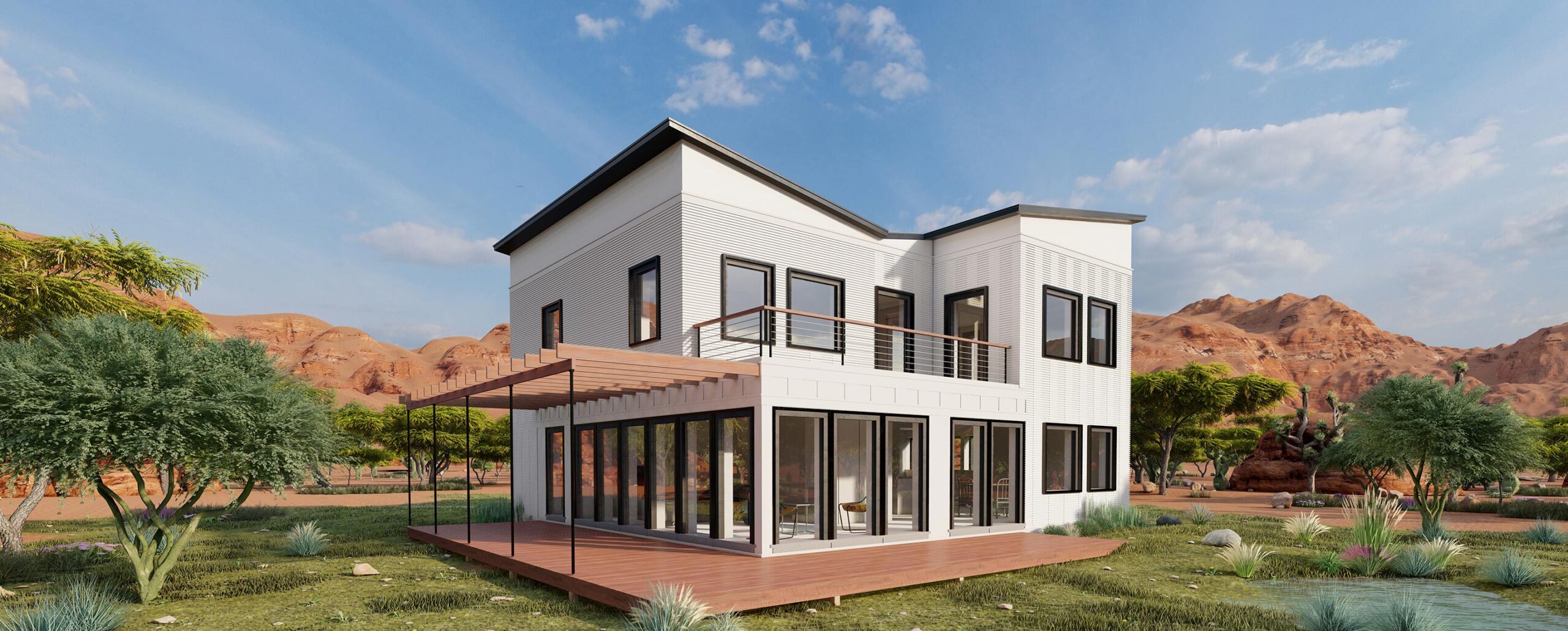Climate Solutions
This Climate Solution is a Sleeping Giant
Published
1 year agoon
By
Nick MandalaA breakthrough technology evolution that can have an enormous, immediate impact
By Nick Mandala, for Positive Energy Action, republished by permission
Sometimes, the most effective and powerful solutions are right in front of us, yet somehow the potential is not immediately recognized.
This is a story about using available knowledge and technology to reduce climate warming GHG emissions to zero, while at the same time creating a new economic model for housing, transportation and, well, life on earth.
Two of the greatest challenges of our time (and one could argue, of all time) are climate change and the affordability crisis in housing worldwide.
Some data on housing, published by WeForum:
- The housing crisis could impact 1.6 billion people by 2025, the World Bank says.
- The world needs to build 96,000 new affordable homes every day to house the estimated 3 billion people who will need access to adequate housing by 2030, UN-Habitat says.
Superficially it would seem that these two challenges are in conflict; doesn’t it cost more to build zero carbon or even carbon negative homes? (negative carbon = produces more energy than it consumes)
What if a combination of existing methods, materials and technology could help solve both problems at once?
< R. Buckminster Fuller, (American architect, designer, inventor, and writer, best known for his geodesic domes) believed in the the ability of technological advancement to do “more and more with less and less until eventually you can do everything with nothing,” that is, an accelerating increase in the efficiency of achieving the same or more output (products, services, information, etc). >
”An accelerating increase in the efficiency of achieving the same or more output”
Before tackling the recipe for creating significantly more affordable housing, while at the same time battling climate change in a big way, it’s helpful to begin with an analogy from sustainable transport design.
Electric vehicles have been around, in primitive form, since the 1830s, nearly two decades before the oil industry officially began in the US.
But, in essence, it took 163 years before efficiency and battery technology were sufficiently developed to make transportation as cheap in an EV as in an ICE car.
( It can be argued that this accomplishment could have happened nearly a century sooner, if not for the threat it posed to the fossil fuel industry.)
The history of the ICE automobile is often one of ignoring efficiency until simply burning more fuel without limits became an issue. R. Buckminster Fuller (see above) designed a “Dymaxion” car in the early 1930s that could transport up to 11 passengers, reach speeds of up to 90 miles per hour, and ran 30 miles per gallon. The combined average mpg for cars and consumer trucks was sill less than 30 in 2011, nearly 80 years later.
The dawn of the EV era, finally
Tesla takes the efficiency of its vehicles very seriously and has made great strides in achieving long battery range and, with the model 3, increased affordability. The three main areas where EV efficiency can be increased are the materials (weight), the highly aerodynamic design (drag coefficient) and, of course, the battery design.
Aptera, a startup company that is targeting 2023 for initial mass production of its radically designed EV, is taking this focus on efficiency a step further in creating a solar powered car.
A great challenge to using solar panels on a passenger vehicle is the small surface-area that is available to mount the panels. For this reason every aspect of the design must be hyper-optimized.
Astoundingly, the Aptera is slated to release a model that can travel 1000 miles on a charge and, under ideal conditions, never need to be charged at all (100% self-charging via integrated solar panels).
Currently the biggest limitation is that the solar panels can only add 40 miles of range per day, meaning if you drive less than 40 miles per day on average you would never need to spend a cent plugging into grid power.
How do they do it? Special hyper-efficient PV panels, a drag coefficient nearly half of a Tesla Model 3 (1.3 vs. 2.3) and an aerodynamic design that makes it look as crazy as you can imagine. (Oh yea, and only 3 wheels)

If this story continues, and companies like Aptera are able to achieve additional incremental gains in efficiency to produce even better solar powered cars, transportation itself could become affordable at a level inconceivable in the current economic system.
Imagine buying a modestly priced vehicle (Aptera’s base model is currently priced at $25k) and never paying to charge it for the life of the car.
This is approaching an example of the “until eventually you can do everything with nothing” part of the quote above. Further gains are possible with continued design evolution.
What if a home, or housing community, could have “Aptera-like” performance?
Aptera formula:
- Solar powered
- Battery back up
- Hyper-efficient design to optimize 1+2
AM51 concept:
- Solar powered
- Battery back up (or geothermal, pumped hydro, etc + hyper-efficient heat pumps and other future tech appliances)
- Hyper-efficient design to optimize 1+2
At AM51 we are working to take decades of accumulated knowledge and use similar design principals, first pioneered by “Bucky” Fuller, in creating a complete “living system” for homes and communities.
The preconception that aerodynamic design and precision to create hyper-efficiencies is fine for cars, boats, aircraft, etc, but of little use in buildings / homes is where the communication challenge lies.
We use the term living system, because, like an EV, all the elements must be designed to work together with optimum performance in order to reach the twin goals of less than zero carbon emissions and achieving that at a price below current, traditionally built, homes and communities.
Also, a combination of the “core and shell” basically the equivalent of the body in a car, along with the power source (rooftop solar) each have to be hyper-efficient and work together at maximum performance.
Add to this eco-friendly insulation and HVAC systems, and something magical happens.
The EV design analogy is apt, also, because we incorporate batteries for backup and load management.

Where the analogy diverges is in the design of the building itself. Drag coefficient is less relevant (unless we create a flying house) but instead the thermal profile and material choices have a huge impact.
The thermal profile is the area where the greatest gains are possible. Traditional homes (and buildings generally) were never designed to take efficient energy use for climate control into account. (This would be the equivalent of driving a rectangular “block-car” EV -Hummer?- and watching your battery reserve disappear in minutes.)
Getting into the details of how exactly the thermal profile is achieved is beyond the scope of this article, however, what we can say is that the increased efficiency (compared to a home built with traditional methods) is achievable to between 80-94%.
In plain English, this is a measurement of how much less energy is needed to heat and cool the home, along with the standard average usage for typical residents (cooking, TVs, computers, etc).
Starting in the 70s, refined in the 90s, passive house standards are the underlying scientific foundation of our work in designing the ultimate thermal profile for homes.
This standard has been underappreciated and is often considered “expensive” which is only true if you look at only one aspect of the design in isolation (like triple pane windows, for example).
As part of a complete system, the real cost, not just in climate terms, is comparable, and, as discussed below, can be significantly less when every element is properly measured. Vastly less expensive and more efficient heat pumps or other new innovative HVAC systems already offset much of the added construction costs of superior materials and quantities.
Every home a power plant and a grid interactive citizen
Unlike an EV such as the Aptera, the roof area of an average sized home has space for a larger number of panels. Therefore, using standard current PV systems, an AM51 home, with an over 85% more efficient energy demand profile, can power itself using only a portion of the space available.
With a system that uses the entire available area, a significant amount of excess power is available to share with the public grid, in exchange for compensation.
All of this can be magnified, particularly in a community setting, once grid-interactive systems and net metering become standard, and laws adapt to maximize this potential.
In a nutshell, our goal is to create a system where a community functions as individual hyper-efficient homes, combined with shared solar power and backup.
The calculated benefits to this total system design are “beyond Aptera” in their potential impact at scale.

Imagine a home that, once paid for via mortgage at a price at or below a traditional home, does not generate a cent in energy bills for up to 25 years…
…and, additionally, will generate monthly income, thus reducing the monthly payments, in some cases significantly.
All of this, while having a negative carbon footprint (more energy produced than consumed), and causing enormous reductions in GHG emissions at scale…
For many, utility bills are not the greatest concern or cost factor they focus on when imagining the cost of home ownership. But the potential – the freedom of a “grid-optional” lifestyle – and the incredible comfort, health and well-being attached to a perfectly climate controlled indoor environment – all this and many more benefits, once experienced, we believe will eventually make traditional home environments obsolete.
“You never change things by fighting the existing reality. To change something, build a new model that makes the existing model obsolete.”
-R. Buckminster Fuller
Adaptation to hotter heat waves and “polar vortexes”, and other unexpected weather events that are now increasingly likely, is an important topic.
Having a living system that can be counted on to keep you warm in winter, cool in the raging summer heat, and all for zero dollars beyond the basic initial costs, must become a minimum standard as we go forward.
Fractalize™, the coup de gras of affordability for the grid-interactive, hyper-efficient home

So much for battling climate change through efficient design and synergistic systems.
In order to reach even greater affordability, for most even more important and extremely meaningful in getting homes to those in need, AM51 homes and communities will need a construction method to reduce actual costs even further.
Labor shortages in construction and supply chain issues for materials, are two major factors that are driving costs up.
Our completely unique pre-manufactured building system, Fractalize™, takes on both issues and more.
With modern, yet simple, computer and robotic assisted manufacturing of building blocks, optimized specifically for home construction, and made exclusively out of plant-based materials (wood and other) far less labor is required.
Building times are up to 10X faster and minimal assembly crews, with no heavy machinery, are all that’s needed.
Again, the specific details of the hybrid-deep-tech-low-tech system are too complex for this article, but the end result of the added layer of efficiency (in this case efficient execution of construction) can result, by our calculations, in up to 15% lower construction costs overall, with additional cost-benefits from the speed to market.
The automated Fractalize™ manufacturing system is planned for mini factories near each region where homes and communities are needed.
It can also be adapted to make use of cost benefits in non-OECD developing economies where using local supply-chain logistics and available labor can lower prices much more for those unique circumstances.
As for North America, imagine owning a home and having your home pay you, provide free energy for a quarter century, yet cost up to 20% less than a comparable home, built old-style!
This, combined with unprecedented healthy, comfortable living, convenience, and elegance will proclaim a new architectural century. And with an Aptera in the driveway you’ll never pay a cent for transportation or utilities for the life of your home and car. Bucky would be winking at the thought…


